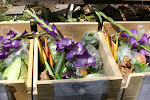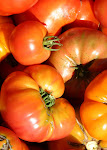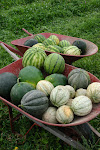
Despite these severely wet past few weeks, the vegetables have been growing well for the most part. According to the Portland Press Herald, by June 30th we had 8 inches of rain: three times average for that month. Luckily, a little water from the sky doesn't stop us, and we have been diligetnly planting successions of our root vegetables. We rake out all our raised beds by hand, and honestly, a cool rainy day is preferable to the hot July sun for this endeavor. While a relentless scorching sun can be trouble for tender seedlings, the waterlogged soil does drown some of the seeds we plant, and they fail to germinate.
It's interesting to observe which families of crops are affected most by the constant rain. The lack of sun does not have a tremendous effect on the brassica family crops -- the broccoli, cabbages, turnips and brussels sprouts are all thriving. The onions and leeks (lily family) also seem to love the constant moisture and are starting to swell up underneath the ground. The cucurbits (all your melons, cucumbers, and squashes) seem to be unaffected in plant size, but slow to flower. For now, the cucumber beetle, which is usually a problem this time of year for all the cucurbits, seems vanquished by the heavy showers. I suspect in downpours they cannot fly from plant to plant. Although, similiarly, the bees cannot fly in this weather, and we are thinking that is the reason that we have so few peas -- lack of pollination.
A week of sunshine and heat will dramatically benefit the nightshades (potatoes, tomatos, eggplants, and peppers), however. They love it hot and bright and are a little small for July. A few weeks ago we succesfuly transplanted the lastof the seedlings into the ground. We planted some of the peppers and eggplants inside our new hoophouse, and we're interested to see the difference in growth rates. So far, the hoophouse group are nearly twice as tall.
One nightshade that doesn't seem to mind not seeing the sun as much is the hardy potato: they are looking lush and bushy. No sign of our nemesis the Colorado Potato Beetle yet, either. Although, the constant humidity (>90%) could be bad news for them, ultimately, since late blight (Phytophthora infestans) has been reported south of Maine and is spreading north. This is a very serious fungal disease, capable of wiping out large quantities of nightshade crops. Spores can travel miles.
If you garden at home, be on the look out for late blight: it starts as gray/olive furry lesions on leaves that eventually result in plant death. Infected plants must be removed, bagged, sealed, and destroyed. Do not compost them. Be especially alert for it if you've purchased seedlings from a large chain store that ships them in from far away.
Well, we are off to prepare our Portland delivery and it finally looks like we've got a little sun this morning. See you all this afternoon.
- Virginia
For more information on Late Blight, check out MOFGA or Cornell's IPM page.










